Mr_Curious
Mechanical
Hello dear friends.
Please, share an information of dynamic viscosity coefficien for iso vg 32 oil for various temperature.
Please, share an information of dynamic viscosity coefficien for iso vg 32 oil for various temperature.

